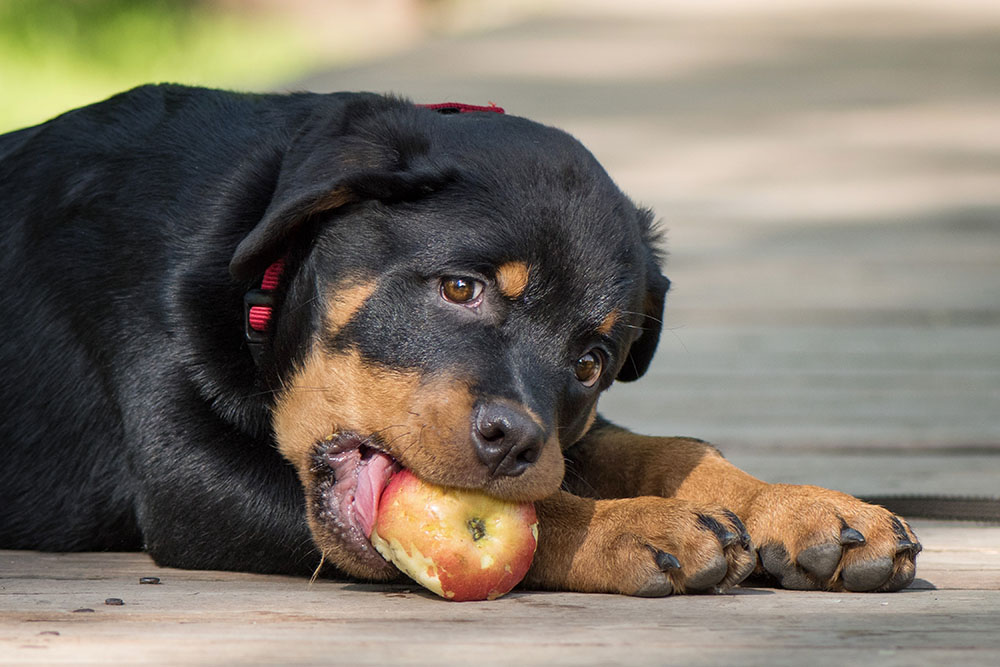Breed Profile – Rottweiler
23/03/2017
This German working breed has an unfair reputation for aggression thanks to its deep protective instinct. In this breed profile, we find out more about the Rottweiler.
History of Breed: Originating in Rottweil, south west Germany, the Rottweiler was a mixture of mastiff-type breeds and sheep dog breeds. It needed to have the skills and intelligence of a sheep dog, but the strength and guarding skills of a guard dog. They also carried money for their owners. Today they work for the armed forces, the police and in search and rescue.
Life Expectancy: Approximately 10 years.
Size: Medium to large breed, with a height range of 58-69cm and a weight range of 38-59kg.
Features: Powerful shoulders, broad deep chest and strong straight legs give the Rottweiler its sturdy, compact form. The characteristic broad head has a well-defined stop, deep muzzle and firm flews. The medium length coat has two layers and can be a little longer on the back of the forelegs and breechings. However, it should never be long or excessively wavy. The coat is always black with distinct tan markings on legs, feet, chest and face. Breed standards are very strict on the shape and location of these markings. Small drop ears combined with a calm gaze give the breed an alert, good humoured expression.
Energy Levels/Exercise Required: Surprisingly agile for the breadth of their shoulders, the Rottweiler is also extremely strong and has high endurance levels. They require plenty of vigorous exercise to tire them out and are particularly good at activities that use all these skills such as bike joring and canicross.
Potential Health Issues: Like all large breeds, hip and elbow dysplasia can be a problem. Rottweilers have a rapid growth rate during puppyhood. Not only can this exacerbate dysplasia if puppies are allowed to over-exercise and jump down from heights, it can also lead to osteochondritis dissecans, a condition affecting the shoulder joints. Rotties are also prone to obesity if overfed and/or underexercised. With obesity being another factor in dysplasia, it is wise to feed to condition with a nutritionally-balanced dog food. Gilpa Kennel is specially formulated for larger breeds and also contains green-lipped mussel extract, a natural source of glucosamine and chondroitin. Along with manganese for ligament health, the joint and bone complex should help protect the joints.
Rottweilers are more susceptible to parvovirus, a potentially fatal disease that affects puppies. Osteosarcoma, a cancerous bone tumour, is also a common cause of death in this breed. A responsible breeder and a vet will be able to advise potential owners on the risks associated with these conditions.
Temperament: The Rottweiler has an unfair reputation for aggression, although it is not naturally aggressive. UK breed standards actually dictate that they should be ‘good natured, not nervous, aggressive or vicious; courageous, biddable, with natural guarding instincts’. The breed’s strong instinct to protect can turn to aggression in the wrong hands however. Rotties need an intelligent owner who understands the breed and will take a firm, positive hand with their training. With appropriate socialisation and training that harnesses their strength and intelligence, the Rottweiler makes for an excellent companion dog.
Family Dog/Child Friendly: As mentioned above, in the right hands, the Rottweiler can make a good family companion. It is always a wise idea to supervise children and dogs. Larger breeds should never be left alone with babies and small children to avoid crushing accidents. Rottweilers benefit most from a large house and garden, which gives them plenty of room to run off excess energy.
Likes: Guarding, protecting, vigorous exercise.
Dislikes: Strangers!!



